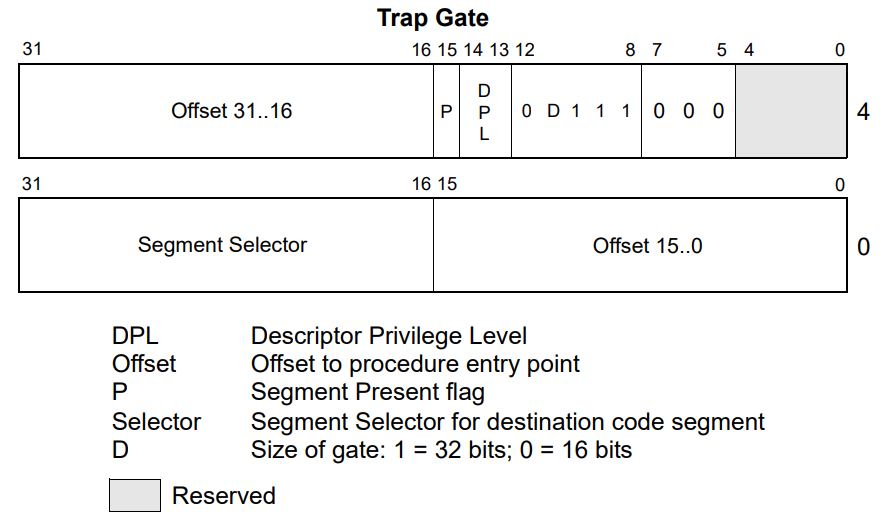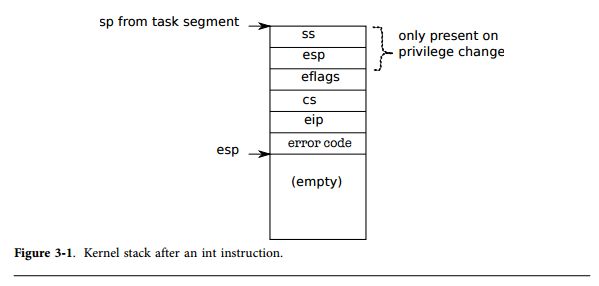本章では特別な役割をもったいろいろなレジスタが出現します。
ここでは詳しい説明を避けますサボります。
その代わりに素晴らしい資料のリンクを貼っておきます。適宜確認することをおすすめします。
Systems calls, exceptions, and interrupts
ユーザプログラムからカーネルに変わる3パターン
- システムコール(Sytem call)
- 例外(Exception)
- 割り込み(Interrupt), トラップ(Trap)
int命令で呼ばれる- トラップ: 現在実行中のプロセスが発生させるもの
- 割り込み: 現在実行中のプロセスとは関係ない
X86 protection
$ 保護レベル%csレジスタの下位2ビットがCPLを示す
- DPL(Descriptor Privilege Level)
- CPL(Current Privilege Level)
0レベル: カーネルモード
3レベル: ユーザモード
$ IDT
IDT: Interrupt Descriptor Table
割り込みとそれに対応するハンドラのテーブル
カーネルはこのテーブルを作る必要がある
詳しいおすすめ記事
$ int命令の処理
int n: n番目のIDTエントリの例外処理中に
%cs%eipを操作する%cs%eipは操作されても困らないようにする必要がある(スタックに退避させるなど)int命令の処理手順(ハードウェアがやる)
- IDTからn番目のディスクリプタをフェッチ
%csのCPLフィールドをチェックがDPL以下であることを確認- ターゲットセグメントセレクタがDPL=<CPLであった場合にのみ、CPUの内部レジスタである
%espと%ssを保存 %ssと%espをタスクセグメントディスクリプタからロード%ss%esp%eflags%cs%eipの順でスタックに積む%eflagsの割り込み可能フラグ(IF)をクリア%csと%eipにディスクリプタの値(詳細は5章,switchuvm()でTSSに値をセットしている)をセット
int実行後のスタックの状態
retではなくiret命令でint命令のスタックを回復
Code: Assembly trap handlers
main.cから呼ばれるtvinit()でIDTのセット
trap.c17 void 18 tvinit(void) 19 { 20 int i; 21 22 for(i = 0; i < 256; i++) 23 SETGATE(idt[i], 0, SEG_KCODE<<3, vectors[i], 0); 24 SETGATE(idt[T_SYSCALL], 1, SEG_KCODE<<3, vectors[T_SYSCALL], DPL_USER); 25 26 initlock(&tickslock, "time"); 27 }L22-23: 256個のIDTエントリを
vectorsに対応しているハンドラにセットL24: システムコール用のIDTエントリをセット
T_SYSCALL(=64番目のエントリ)だけはユーザレベル(∵ 第4引数がDPL_USER)で呼び出し可能
第二引数が1、つまりトラップである
161 // - istrap: 1 for a trap (= exception) gate, 0 for an interrupt gate. 162 // interrupt gate clears FL_IF, trap gate leaves FL_IF alone 163 // - sel: Code segment selector for interrupt/trap handler 164 // - off: Offset in code segment for interrupt/trap handler 165 // - dpl: Descriptor Privilege Level - 166 // the privilege level required for software to invoke 167 // this interrupt/trap gate explicitly using an int instruction. 168 #define SETGATE(gate, istrap, sel, off, d) \vectors.plvectors(アセンブリ:vectors.S)を作るPerl製のコードジェネレータ``` perl 29 # sample output: 30 # # handlers 31 # .globl alltraps 32 # .globl vector0 33 # vector0: 34 # pushl $0 35 # pushl $0 36 # jmp alltraps 37 # ... ```- L34 - 35: 後述する
trapframeに値をセット- L34:
trapframeのerrの値
処理によってはCPUによって自動で積まれる(e.x. PageFault) - L35:
trapframeのtrapnoの値
何の処理なのかを振り分ける値(trap()で使われる)
- L34:
- L36: 全てのvectorは
alltrapsに飛ぶ
- L34 - 35: 後述する
mmu.h``` c 147 // Gate descriptors for interrupts and traps 148 struct gatedesc { 149 uint off_15_0 : 16; // low 16 bits of offset in segment 150 uint cs : 16; // code segment selector 151 uint args : 5; // # args, 0 for interrupt/trap gates 152 uint rsv1 : 3; // reserved(should be zero I guess) 153 uint type : 4; // type(STS_{IG32,TG32}) 154 uint s : 1; // must be 0 (system) 155 uint dpl : 2; // descriptor(meaning new) privilege level 156 uint p : 1; // Present 157 uint off_31_16 : 16; // high bits of offset in segment 158 }; ~~~ 160 // Set up a normal interrupt/trap gate descriptor. 161 // - istrap: 1 for a trap (= exception) gate, 0 for an interrupt gate. 162 // interrupt gate clears FL_IF, trap gate leaves FL_IF alone 163 // - sel: Code segment selector for interrupt/trap handler 164 // - off: Offset in code segment for interrupt/trap handler 165 // - dpl: Descriptor Privilege Level - 166 // the privilege level required for software to invoke 167 // this interrupt/trap gate explicitly using an int instruction. 168 #define SETGATE(gate, istrap, sel, off, d) \ 169 { \ 170 (gate).off_15_0 = (uint)(off) & 0xffff; \ 171 (gate).cs = (sel); \ 172 (gate).args = 0; \ 173 (gate).rsv1 = 0; \ 174 (gate).type = (istrap) ? STS_TG32 : STS_IG32; \ 175 (gate).s = 0; \ 176 (gate).dpl = (d); \ 177 (gate).p = 1; \ 178 (gate).off_31_16 = (uint)(off) >> 16; \ 179 } ``` >
Intel SDM Volume 3 Chapter 6
ここまででIDEのセットが終わりました。次に実際に呼び出されたときの処理を見ていきます。
まずは前述したとおり、全てのハンドラはalltrapsを呼び出します。
alltraps
構造体trapframeを構築し, 構築したtrapframeを引数としてtrap()呼び出すx86.h``` c 147 //PAGEBREAK: 36 148 // Layout of the trap frame built on the stack by the 149 // hardware and by trapasm.S, and passed to trap(). 150 struct trapframe { 151 // registers as pushed by pusha 152 uint edi; 153 uint esi; 154 uint ebp; 155 uint oesp; // useless & ignored 156 uint ebx; 157 uint edx; 158 uint ecx; 159 uint eax; 160 161 // rest of trap frame 162 ushort gs; 163 ushort padding1; 164 ushort fs; 165 ushort padding2; 166 ushort es; 167 ushort padding3; 168 ushort ds; 169 ushort padding4; 170 uint trapno; 171 172 // below here defined by x86 hardware 173 uint err; 174 uint eip; 175 ushort cs; 176 ushort padding5; 177 uint es; 178 179 // below here only when crossing rings, such as from user to kernel 180 uint esp; 181 ushort ss; 182 ushort padding6; 183 }; ``` `alltraps`が呼び出される時点でL182 - 169まではスタックに積んである状態trapasm.S``` c 3 # vectors.S sends all traps here. 4 .globl alltraps 5 alltraps: 6 # Build trap frame. 7 pushl %ds 8 pushl %es 9 pushl %fs 10 pushl %gs 11 pushal 12 13 # Set up data segments. 14 movw $(SEG_KDATA<<3), %ax 15 movw %ax, %ds 16 movw %ax, %es 17 18 # Call trap(tf), where tf=%esp 19 pushl %esp 20 call trap 21 addl $4, %esp 22 23 # Return falls through to trapret... 24 .globl trapret 25 trapret: 26 popal 27 popl %gs 28 popl %fs 29 popl %es 30 popl %ds 31 addl $0x8, %esp # trapno and errcode 32 iret ``` - L6 - 11: `trapframe`を構築 - L15 - 16: データセグメントをセットする - `%ds`: データセグメント - `%es`: エクストラセグメント >
L16でのスタックの状態
Code: C trap handler
trap()alltrapsから呼ばれる36 //PAGEBREAK: 41 37 void 38 trap(struct trapframe *tf) 39 { 40 if(tf->trapno == T_SYSCALL){ 41 if(myproc()->killed) 42 exit(); 43 myproc()->tf = tf; 44 syscall(); 45 if(myproc()->killed) 46 exit(); 47 return; 48 } 49 50 switch(tf->trapno){ . . .IDTエントリにセットされているハンドラで積まれている
trapnoによって処理を振り分ける
Code: System calls
ここではtrap()から呼び出されるのがシステムコールの場合の処理を追っていきます。
まずは最初のシステムコールの呼び方みてxv6でのシステムコールの呼び方を見ていきます。(該当の章は Code: The first system call)
initcode.S8 # exec(init, argv) 9 .globl start 10 start: 11 pushl $argv 12 pushl $init 13 pushl $0 // where caller pc would be 14 movl $SYS_exec, %eax 15 int $T_SYSCALL- L11 - 12: 引数をスタックに積む
- L13: システムコールから戻るときのアドレスをスタックに積む
- 最初のシステムコールのため戻ってくることはないため適当な値
call命令は自動的に戻るときのアドレスをスタックに積む
- L14:
%eaxに該当するシステムコールの番号を格納 - L15:
intでシステムコールを呼び出し
xv6のシステムコールの処理を追っていきます。
前述したtrap()からsyscall()が呼ばれたところからです。
syscall.c131 void 132 syscall(void) 133 { 134 int num; 135 struct proc *curproc = myproc(); 136 137 num = curproc->tf->eax; 138 if(num > 0 && num < NELEM(syscalls) && syscalls[num]) { 139 curproc->tf->eax = syscalls[num](); 140 } else { 141 cprintf("%d %s: unknown sys call %d\n", 142 curproc->pid, curproc->name, num); 143 curproc->tf->eax = -1; 144 } 145 }- L137:
trapframeの%eaxから該当するシステムコールの番号を取り出し呼ぶ - L139, 143: 返り値を
trapframeの%eaxに格納システムコールは
%eaxに返り値が格納されているL143: エラー時の処理
L139: システムコールの実行
``` c 107 static int (*syscalls[])(void) = { 108 [SYS_fork] sys_fork, 109 [SYS_exit] sys_exit, 110 [SYS_wait] sys_wait, 111 [SYS_pipe] sys_pipe, 112 [SYS_read] sys_read, 113 [SYS_kill] sys_kill, 114 [SYS_exec] sys_exec, . . . ```
- L137:
引数のヘルパー関数:
argint()
前提: システムコールの呼び出しはスタック(tf->esp)に積まれている使われ方の例
``` c 286 int 287 sys_open(void) 288 { 289 char *path; 290 int fd, omode; 291 struct file *f; 292 struct inode *ip; 293 294 if(argstr(0, &path) < 0 || argint(1, &omode) < 0) 295 return -1; ``` - L294: - 第1引数: 何個目の引数か - 第2引数: 引数の値を入れる変数syscall.c``` c 48 // Fetch the nth 32-bit system call argument. 49 int 50 argint(int n, int *ip) 51 { 52 return fetchint((myproc()->tf->esp) + 4 + 4*n, ip); 53 } ``` - L52: - `+4`: `call`命令で積まれた戻るためのアドレスが格納されている - `+4*n`: 該当の引数までsyscall.c``` c 16 // Fetch the int at addr from the current process. 17 int 18 fetchint(uint addr, int *ip) 19 { 20 struct proc *curproc = myproc(); 21 22 if(addr >= curproc->sz || addr+4 > curproc->sz) 23 return -1; 24 *ip = *(int*)(addr); 25 return 0; 26 } ```- L22: ユーザー空間からの引数なので注意が必要
- L24: 読み込む
他にも
argptr()argstr()argfd()などある
Exercises
commentary/textbook についてる問題の僕の回答を載せておきます。
Add a new system call to get the current UTC time and return it to the user program. You may want to use the helper function, cmostime (7552), to read the real time clock. The file date.h contains the definition of the struct rtcdate (0950), which you will provide as an argument to cmostime as a pointer.
次回はtrap()から呼び出されるのが割り込みだった場合の処理、ドライバを追っていきます。
